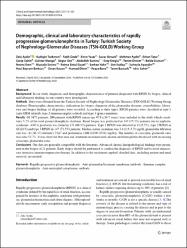Demographic, clinical and laboratory characteristics of rapidly progressive glomerulonephritis in Turkey: Turkish Society of Nephrology-Glomerular Diseases (TSN-GOLD) Working Group

Göster/
Erişim
info:eu-repo/semantics/embargoedAccessTarih
2021Yazar
Aydın, ZekiTürkmen, Kültigin
Dede, Fatih
Yaşar, Emre
Öztürk, Savaş
Aydın, Mehmet
Tatar, Erhan
Şahin, Garip
Manga, Gülizar
Oto, Özgür
Şumnu, Abdullah
Eroğlu, Eray
Dinçer, Tamer
Dursun, Belda
Eren, Necmi
Sevinç, Mustafa
Güzel, Fatma Betül
Yalın, Serkan
Kutlay, Sim
Apaydın, Süheyla
Berktaş, Hacı Bayram
Kazan, Sinan
Dheir, Hamad
Bora, Feyza
Baştürk, Taner
Şahin, İdris
Üst veri
Tüm öğe kaydını gösterKünye
Aydın, Z., Türkmen, K., Dede, F., Yaşar, E., Öztürk, S., Aydın, M. ... Şahin, İ. (2021). Demographic, clinical and laboratory characteristics of rapidly progressive glomerulonephritis in Turkey: Turkish Society of Nephrology-Glomerular Diseases (TSN-GOLD) Working Group. Clinical and Experimental Nephrology, 25(2), 173-183. https://dx.doi.org/10.1007/s10157-020-01978-6Özet
Background In our study, diagnostic and demographic characteristics of patients diagnosed with RPGN by biopsy, clinical and laboratory findings in our country were investigated. Methods Data were obtained from the Turkish Society of Nephrology Glomerular Diseases (TSN-GOLD) Working Group database. Demographic characteristics, indications for biopsy, diagnosis of the glomerular diseases, comorbidities, laboratory and biopsy findings of all patients were recorded. According to their types, RPGN patients were classified as type 1 (anti-GBM related), type 2 (immuncomplex related) and type 3 (pauci-immune). Results Of 3875 patients, 200 patients with RPGN (mean age 47.9 +/- 16.7 years) were included in the study which constitutes 5.2% of the total glomerulonephritis database. Renal biopsy was performed in 147 (73.5%) patients due to nephritic syndrome. ANCA positivity was found in 121 (60.5%) patients. Type 1 RPGN was detected in 11 (5.5%), type 2 RPGN in 42 (21%) and type 3 RPGN in 147 (73.5%) patients. Median serum creatinine was 3.4 (1.9-5.7) mg/dl, glomerular filtration rate was 18 (10-37) ml/min/1.73m(2)and proteinuria 2100 (1229-3526) mg/day. The number of crescentic glomeruli ratio was ratio 52.7%. It was observed that urea and creatinine increased and calcium and hemoglobin decreased with increasing crescentic glomerular ratio. Conclusions Our data are generally compatible with the literature. Advanced chronic histopathological findings were prominent in the biopsy of 21 patients. Early biopsy should be performed to confirm the diagnosis of RPGN and to avoid unnecessary intensive immunosuppressive therapy. In addition to the treatments applied, detailed data, including patient and renal survival, are needed.
WoS Q Kategorisi
Q3Scopus Q Kategorisi
Q2Kaynak
Clinical and Experimental NephrologyCilt
25Sayı
2Koleksiyonlar
- Makale Koleksiyonu [3809]
- PubMed İndeksli Yayınlar Koleksiyonu [4279]
- Scopus İndeksli Yayınlar Koleksiyonu [6642]
- WoS İndeksli Yayınlar Koleksiyonu [6717]

















